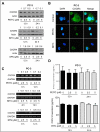CXCR4 is a novel target of cancer chemopreventative isothiocyanates in prostate cancer cells
- PMID: 25712054
- PMCID: PMC4417382
- DOI: 10.1158/1940-6207.CAPR-14-0386
CXCR4 is a novel target of cancer chemopreventative isothiocyanates in prostate cancer cells
Abstract
Isothiocyanates (ITCs) derived from cruciferous vegetables, including phenethyl isothiocyanate (PEITC) and sulforaphane (SFN), exhibit in vivo activity against prostate cancer in a xenograft and transgenic mouse model, and thus are appealing for chemoprevention of this disease. Watercress constituent PEITC and SFN-rich broccoli sprout extract are under clinical investigations but the molecular mechanisms underlying their cancer chemopreventive effects are not fully understood. The present study demonstrates that chemokine receptor CXCR4 is a novel target of ITCs in prostate cancer cells. Exposure of prostate cancer cells (LNCaP, 22Rv1, C4-2, and PC-3) to pharmacologically applicable concentrations of PEITC, benzyl isothiocyanate (BITC), and SFN (2.5 and 5 μmol/L) resulted in downregulation of CXCR4 expression. None of the ITCs affected secretion of CXCR4 ligand (stromal-derived factor-1). In vivo inhibition of PC-3 xenograft growth upon PEITC treatment was associated with a significant decrease in CXCR4 protein level. A similar trend was discernible in the tumors from SFN-treated TRAMP mice compared with those of control mice, but the difference was not significant. Stable overexpression of CXCR4 in PC-3 cells conferred significant protection against wound healing, cell migration, and cell viability inhibition by ITCs. Inhibition of cell migration resulting from PEITC and BITC exposure was significantly augmented by RNAi of CXCR4. This study demonstrates, for the first time, that cancer chemopreventive ITCs suppress CXCR4 expression in prostate cancer cells in vitro as well as in vivo. These results suggest that CXCR4 downregulation may be an important pharmacodynamic biomarker of cancer chemopreventative ITCs in prostate adenocarcinoma.
©2015 American Association for Cancer Research.
Figures






References
-
- Hecht SS. Chemoprevention of cancer by isothiocyanates, modifiers of carcinogen metabolism. J Nutr. 1999;129:768–74. suppl. - PubMed
-
- Wattenberg LW. Inhibition of carcinogenic effects of polycyclic hydrocarbons by benzyl isothiocyanate and related compounds. J Natl Cancer Inst. 1977;58:395–8. - PubMed
-
- Ketterer B. Dietary isothiocyanates as confounding factors in the molecular epidemiology of colon cancer. Cancer Epidemiol Biomarkers Prev. 1998;7:645–6. - PubMed
-
- van Poppel G, Verhoeven DT, Verhagen H, Goldbohm RA. Brassica vegetables and cancer prevention. Epidemiology and mechanisms. Adv Exp Med Biol. 1999;472:159–68. - PubMed
Publication types
MeSH terms
Substances
Grants and funding
LinkOut - more resources
Full Text Sources
Other Literature Sources
Medical
Research Materials
Miscellaneous

